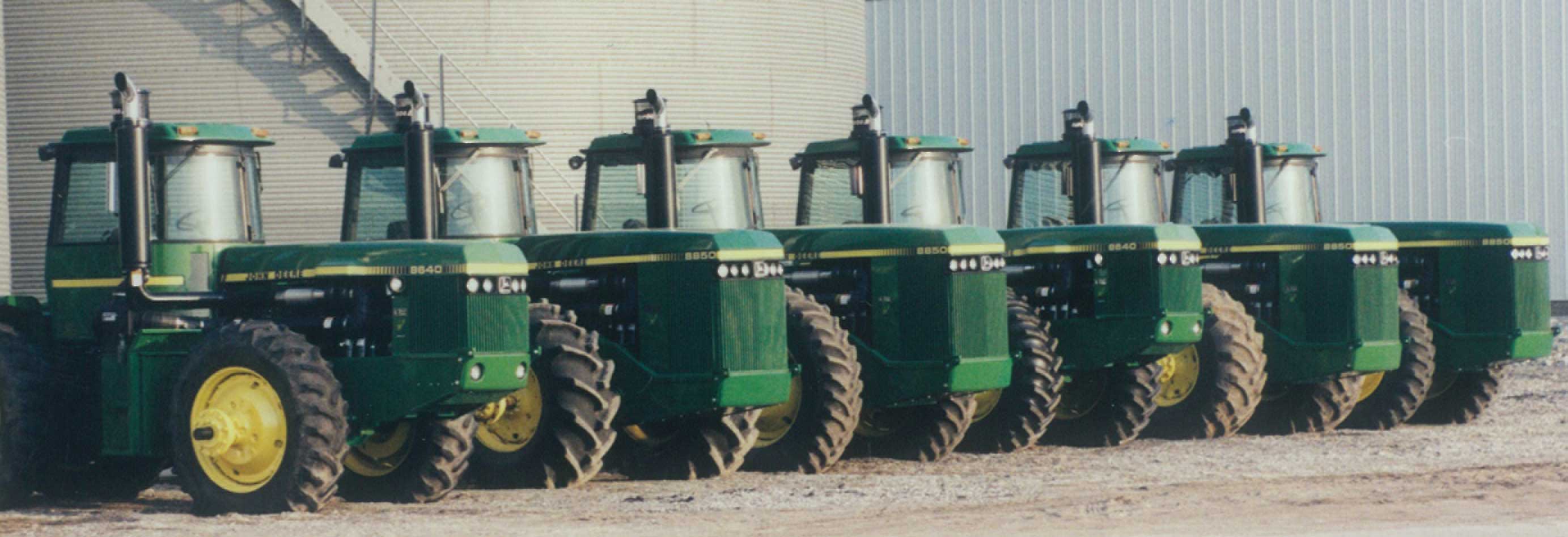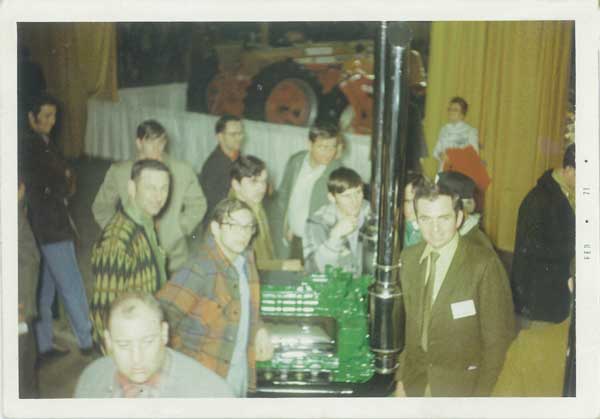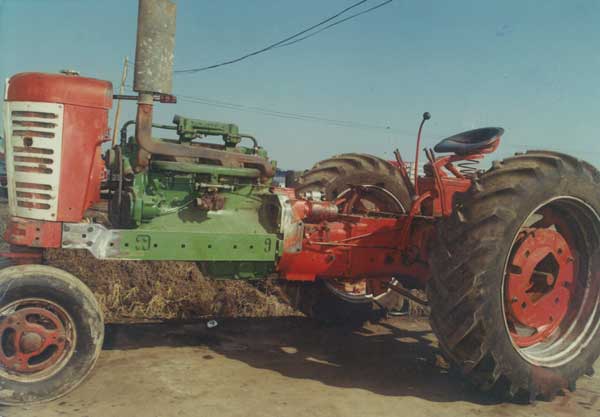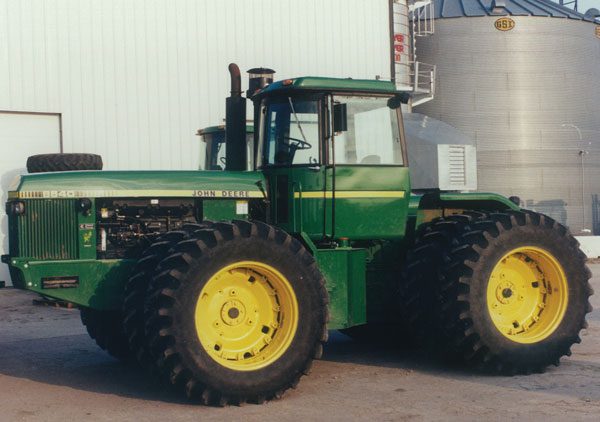
Only three years after opening his small welding shop, Jon had forged a solid reputation for being able to complete tough modification jobs. With a skilled hand, a sharp mind, and the courage to take on any challenge, Jon tackled a farmer’s request to fit a Detroit 8V-71 engine into a brand new John Deere 5020. At the time, the term “re-power” wasn’t even part of the farmer’s vocabulary, but it soon would be, as Jon explains below.
Kinze Welding Re-powers
We started doing tractor re-powers in 1968, but the concept of re-powering wasn’t exactly new. Farmers had been frustrated by the lack of power in their tractors for a long time and had been experimenting with different engines. I had seen my first re-power several years earlier when my Uncle Fritz dropped a Chevy six-cylinder engine and transmission into an old Farmall F-20. I was intrigued with it and knew enough about what he did and how he did it that it occurred to me there were some things I would have done differently. I remember telling my dad, “I believe I can do that, but better.” I suppose I was pretty cocky about my abilities when it came to repairs, welding and making things. My dad just said, “Yeahhhh … ” He didn’t want to encourage or discourage me.
The natural question, of course, is why there was a need to re-power a brand new 5020, billed by John Deere as one of the most powerful tractors made, in the first place?
Well, John Deere had limited the horsepower by design, thinking the excess power would be hard on transmissions, etc. We proved Deere’s engineers wrong at the 1971 Farm Progress Show. A re-powered 5020 pulled our patented, adjustable-width seven-bottom plow in a demonstration. That opened a lot of eyes.
Years earlier, in the spring of 1967, Ronald Mohr, a longtime personal friend, called me. He had noticed a picture of a big four-wheeled wagon made out of truck wheels in the Sunday paper, and it was near Mason City, Iowa. He said, “Jon, let’s take a drive up there and look at this wagon.” In the process of driving there and back, we remembered there was a guy by the name of Clarence Carlson who lived around Le Grand, Iowa, who had put a Detroit engine in a John Deere tractor. So we dropped in on him. That visit became one of the most important moments in Kinze history.
Clarence was one of the most delightful men I’ve ever met, a very positive-thinking guy who was intrigued with engineering. He was an accomplished welder and mechanic and had done some custom designing and building. He showed me pictures of a wrap-around bumper for the front of a Ford tractor that he owned the patent on. I had a handful of pictures with me of some projects I had built: the re-powers, end loaders, floaters and a few welding projects to give him an idea of the work I was doing. Clarence was especially interested in re-powers and was showing us a John Deere 5020 with a 300-horsepower V-8 engine that a man in Illinois had re-powered. Clarence said, “He’s been putting these big engines in, but he’s having trouble with the clutch. The clutch isn’t heavy enough to hold the horsepower. Re-powering is really the way to go, but I don’t have the time or space to do it. We need somebody to take this over.” I told him I could probably figure out the clutch issue, and as a result of that meeting, Clarence promptly came down to see where I was located. He was intrigued with my little old shop and the work we were doing and gave me the name of a farmer who wanted one of these re-powers in the worst way. He said, “You talk to him. His name is David Bystricky.” And then he added, “My neighbors, Don and Wes Hoover, want to re-power a couple of tractors, too.” Clarence told me, “This thing is bigger than you realize.” He was sure right about that.
Dave Bystricky, a soybean and corn farmer from Reinbeck, Iowa, brought in his new John Deere 5020 along with a 320-horsepower Detroit diesel he wanted me to put in it. That was the first of about 200 re-powers of the 5020 I would do. Then I tackled the clutch problem. John Deere had a specific bolt pattern on the bellhousing and other design features that really made it difficult. So instead of using the John Deere clutch and flywheel, I used a truck clutch, which was bigger in diameter and was also double-plated. But there was no way to drive the power takeoff, so I modified the clutch cover and designed an adapter that accomplished the live-driving of the power takeoff shaft, plus a way to release the clutch for the transmission.
We had a little problem getting some of the adapters we made to line up with the factory parts, but I learned through trial and error, and frustration, how to use dial calipers, micrometers and verniers — the big slide rule calipers that measure outside diameters — and made those plates at the proper dimensions.
When we were finished, we ended up with a V-8 engine that was exactly the same length as the John Deere engine it replaced. But instead of having a six-cylinder engine with 141 horsepower, we had a V-8 engine with 318 horsepower. We hand-made the manifolds and put the air cleaner out in front of the tractor because it needed to be a lot bigger for that type of engine.
Dave Bystricky was just delighted with his tractor, which led to another. Clarence Carlson, meanwhile, was the most enthusiastic, complimentary coach you could ever ask for. He came down quite often to see the progress and raved about what we were doing. He was a real friend and promoter. His neighbors, the Hoovers, brought in a pair of 4020s they wanted to re-power with V-6 Detroits, so I had four brand new tractors to re-power. It was April at the time, and these guys were getting pretty nervous about having them ready in time for spring field work.
It took 18-hour days, but we got those tractors re-powered. And as word got around, we wound up doing multiples of them. Re-power is what got us noticed throughout the Midwest and also in Canada. This allowed me to meet a lot of interesting people, including many progressive farmers and larger farmers. Satisfied customers brought more customers and, all of a sudden, I had more business than I knew what to do with. That word-of-mouth marketing helped drive sales of the grain wagons beginning in 1971, and the planters in 1975.
Working with farmers and re-powering their tractors taught me one huge lesson in my early career: some of the best ideas typically come from farmers, contrary to what the major corporations would like to admit. If farmers can’t get what they want from a manufacturer, they get together with their neighbors in a farm shop, or at a blacksmith shop or machine shop, and usually figure it out. Nine out of ten ideas, if not ten out of ten, come from farmers. Why? Because the engineer, unless he’s farming, doesn’t appreciate the need. You can’t solve a problem correctly, efficiently and economically if you aren’t involved in it. And if you aren’t out there farming, you aren’t involved.
As a result of the re-powering, we could see the need for more room. So in 1969, I went to the bank to get a $25,000 loan for a new building. I got it, and purchased a building that was made in Monticello, Iowa. It was more than three times larger than the one we had before. As my dad and I stood looking at that new 5,000-square-foot shop, he said, “How are we going to find our tools now?”
In 1974, I needed $25,000 for operating capital but was turned down for a bank loan because I didn’t have enough collateral. I went to a prominent local businessman, Junie Manatt, and asked if he would co-sign the loan. He agreed, and when I went back to the bank to ask them to get the papers drawn up, the banker had a change of heart. He said if Junie had that much faith in me, so should the bank and I got the loan without a co-signer or collateral.
During that time, we changed the name of the company. Once we got into custom-building loaders, floaters, the anhydrous bar, the first grain wagon and the re-powers, we were fabricating and were no longer just a welding shop. So we called it Kinze Custom Fabrication, but only briefly. In 1972, we incorporated as Kinze Manufacturing, Inc.
We had a lot of fun for a little while taking our F-30 Farmall, powered with a Chevy 409, and a Chevy 427-powered Farmall “M” to tractor-pulling contests around the state of Iowa. Of course, a welding shop on a thin budget, struggling for profit, had no business building pulling tractors and driving hundreds of miles to the contests. It didn’t make a lot of sense financially, but I had not learned that yet.
I also was naive enough to think that those tractor pulls were on the up and up. It turned out there was a lot of cheating going on, with judges often looking the other way when it came to hometown favorites. Weight was being illegally added after the weigh-in, and drawbar heights were being illegally adjusted. After a few times of dealing with that kind of nonsense, I determined that it wasn’t for me. I wanted to compete in business with John Deere and other big companies.
Kinze Power Products, 1988–2007
In 1988, recognizing the demand for replacement engines on the 86 Series John Deere four-wheel-drive tractors, Kinze jumped back into the re-power business. One of the first projects was re-powering a John Deere 8630 with a Cummins 855 engine. The project proved so interesting and successful that, one year later, Kinze created Kinze Power Products, Inc., an autonomous operating company. From 1988 through 2007, Kinze Power Products re-powered over 600 John Deere 8630s, 8640s, 8650s and 8850s for farmers throughout North America and in key export markets.
As with other Kinze innovations, Jon Kinzenbaw found ways to make existing equipment better. The re-powers increased the value and performance of the classic workhorse John Deere four-wheel-drive tractors, giving farmers the best of both worlds: increased torque and lugging power, better fuel efficiency, and improved engine reliability combined with the smooth ride and row crop handling features of the popular tractors. Innovative Kinze designs, such as the forward-tilt engine hood design, and a side-mounted air cleaner and exhaust, made the John Deere tractors more user-friendly. Kinze re-powers delivered tremendous savings compared to the cost of purchasing a new tractor.
Story Notes
The preceding story is an excerpt from Jon Kinzenbaw’s book, 50 Years of Disruptive Innovation, second printing, ©2021, Kinze Manufacturing, Inc.
A John Deere 5020 re-power is on permanent display at Kinze’s Innovation Center in Williamsburg, Iowa. Plan a trip to Kinze to see the 5020 re-power, other Kinze innovations, and the factory for yourself.
Additional Information
Watch the 5020 with a 7-bottom plow operating in Kinze’s 50th Anniversary video (2015).
Purchase the book, 50 Years of Disruptive Innovation, for this story and many others about Jon’s early years and the growth of Kinze.
Purchase the children’s books, Big Blue & Polly and A Tractor & His Boy, and read the stories of some of Jon Kinzenbaw’s tractors to your children or grandchildren.
Do you have a John Deere 4WD re-powered by Kinze Power Products and do need repair information? While Kinze no longer re-powers tractors, here are some resources to help you rebuild the gearbox and find replacement components used in these re-powers.



